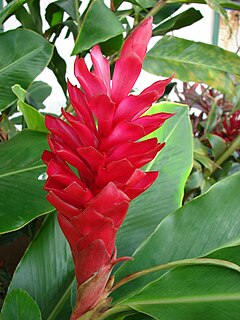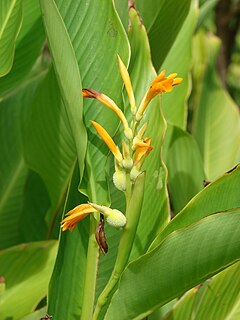
The Zingiberales are flowering plants forming one of four orders in the commelinids clade of monocots, together with its sister order, Commelinales. The order includes 68 genera and 2,600 species. Zingiberales are a unique though morphologically diverse order that has been widely recognised as such over a long period of time. They are usually large herbaceous plants with rhizomatous root systems and lacking an aerial stem except when flowering. Flowers are usually large and showy, and the stamens are often modified (staminodes) to also form colourful petal-like structures that attract pollinators.

Canna or canna lily is the only genus of flowering plants in the family Cannaceae, consisting of 10 species. Cannas are not true lilies, but have been assigned by the APG II system of 2003 to the order Zingiberales in the monocot clade Commelinids, together with their closest relatives, the gingers, spiral gingers, bananas, arrowroots, heliconias, and birds of paradise.

Canna indica, commonly known as Indian shot, African arrowroot, edible canna, purple arrowroot, Sierra Leone arrowroot, is a plant species in the family Cannaceae. It is native to much of South America, Central America, the West Indies, and Mexico. It is also naturalized in the southeastern United States, and much of Europe, sub-Saharan Africa, Southeast Asia, and Oceania. Canna indica has been a minor food crop cultivated by indigenous peoples of the Americas for thousands of years.

Canna discolor also known as Achira in Colombia is a species of the Canna genus, belonging to the family Cannaceae, found naturally in the range from South Mexico to Colombia, widely introduced elsewhere. It is a perennial growing to 3m. It is hardy to zone 10 and is frost tender. In the north latitudes it is in flower from August to October, and the seeds ripen in October. The flowers are hermaphrodite.

Canna glauca is a species of the Canna genus, a member of the family Cannaceae. It is commonly known as water canna or Louisiana canna. It is native to the wetlands of tropical America and was introduced to England in 1730. It is also reportedly naturalized in Sri Lanka, Thailand, Vietnam, Java and the Philippines.

Canna coccinea is a species of the Canna genus, belonging to the family Cannaceae. A native of northern Argentina., it was introduced in England from South America in 1731.

Canna compacta Roscoe is a species of the Canna genus, belonging to the family Cannaceae, distributed between the south of Brazil and northern Argentina. Introduced to England from South America in 1820. Not to be confused with C. compacta Bouché, which is a synonym of C. indica L.

Canna tuerckheimii is a species of the Canna genus, belonging to the family Cannaceae. Its specific epithet tuerckheimii commemorates Hans von Türckheim, a 19th-century German plant collector.
Canna bangii is a species of herb in the family Cannaceae. It is native to Peru and Bolivia.

Canna patens is a species of herb in the Cannaceae family.

Canna pedunculata is a species of the Canna genus, belonging to the family Cannaceae. Native of south-east Brazil at low altitudes. Johnson's Dictionary of 1856 reports that it first entered England in 1820, pedunculata meaning 'long-flower-stalked'.

Canna jaegeriana is a species of herb in the family Cannaceae.

Canna paniculata Ruiz & Pav. is a species of the Canna genus, belonging to the family Cannaceae. Native of southern Mexico, Costa Rica, and tropical South America, except for the Amazon Basin, at 200-2,000m (650-6,500 ft).

Canna speciosa (Roscoe) Hook. is a species of the Canna genus, belonging to the family Cannaceae, a native of the tropical Americas. Introduced to England from South America in 1820, speciosa meaning 'showy'..

Nobuyuki Tanaka is an economic botanist at the Tokyo Metropolitan University, the Makino Botanical Garden in Kōchi Prefecture, Japan.
Canna amabilis is a species of herb in the family Cannaceae. It is native to Northern Argentina.

Cautleya is a small genus of perennial plants of the family Zingiberaceae, found in the eastern Himalayas through to China and Vietnam. It consists of two species of high-altitude tropical and temperate plants, native to cool forest areas – an unusual habitat for members of the Zingiberaceae. They are grown as ornamental flowering plants.

Zanthoxylum armatum, also called winged prickly ash or rattan pepper in English, is a species of plant in the family Rutaceae. It is an aromatic, deciduous, spiny shrub growing to 3.5 metres (11 ft) in height, endemic from Pakistan across to Southeast Asia and up to Korea and Japan. It is one of the sources of the spice Sichuan pepper, and also used in folk medicine, essential oil production and as an ornamental garden plant.















